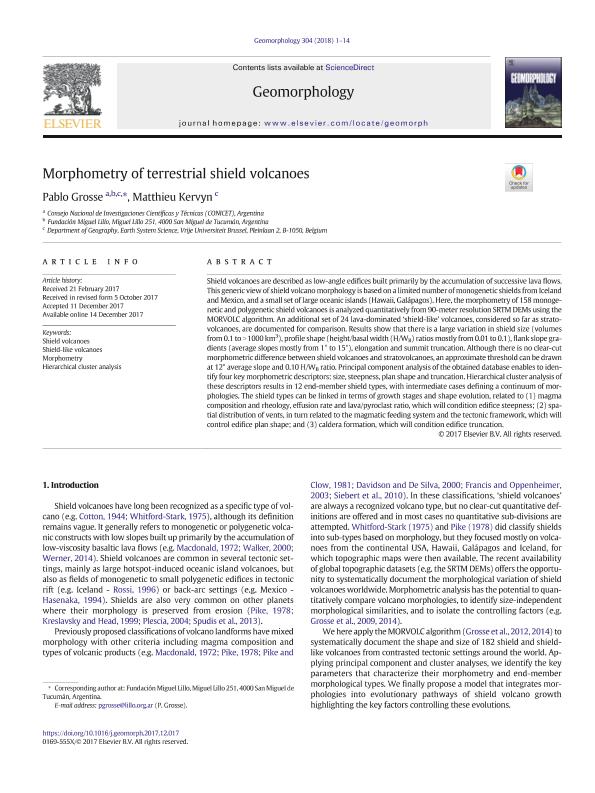Mostrar el registro sencillo del ítem
dc.contributor.author
Grosse, Pablo

dc.contributor.author
Kervyn, Matthieu
dc.date.available
2019-08-08T15:51:19Z
dc.date.issued
2018-03
dc.identifier.citation
Grosse, Pablo; Kervyn, Matthieu; Morphometry of terrestrial shield volcanoes; Elsevier Science; Geomorphology; 304; 3-2018; 1-14
dc.identifier.issn
0169-555X
dc.identifier.uri
http://hdl.handle.net/11336/81219
dc.description.abstract
Shield volcanoes are described as low-angle edifices built primarily by the accumulation of successive lava flows. This generic view of shield volcano morphology is based on a limited number of monogenetic shields from Icelandand Mexico, and a small set of large oceanic islands (Hawaii, Galápagos). Here, the morphometry of 158 monogenetic and polygenetic shield volcanoes is analyzed quantitatively from 90-meter resolution SRTM DEMs using the MORVOLC algorithm. An additional set of 24 lava-dominated ?shield-like? volcanoes, considered so far as stratovolcanoes, are documented for comparison. Results show that there is a large variation in shield size (volumes from 0.1 to >1000 km3), profile shape (height/basal width (H/WB) ratios mostly from 0.01 to 0.1), flank slope gradients (average slopes mostly from 1° to 15°), elongation and summit truncation. Although there is no clear-cut morphometric difference between shield volcanoes and stratovolcanoes, an approximate threshold can be drawnat 12° average slope and 0.10 H/WB ratio. Principal component analysis of the obtained database enables to identify four key morphometric descriptors: size, steepness, plan shape and truncation. Hierarchical cluster analysis ofthese descriptors results in 12 end-member shield types, with intermediate cases defining a continuum of morphologies. The shield types can be linked in terms of growth stages and shape evolution, related to (1) magma composition and rheology, effusion rate and lava/pyroclast ratio, which will condition edifice steepness; (2) spatial distribution of vents, in turn related to the magmatic feeding system and the tectonic framework, which will control edifice plan shape; and (3) caldera formation, which will condition edifice truncation.
dc.format
application/pdf
dc.language.iso
eng
dc.publisher
Elsevier Science

dc.rights
info:eu-repo/semantics/openAccess
dc.rights.uri
https://creativecommons.org/licenses/by-nc-sa/2.5/ar/
dc.subject
Shield Volcanoes
dc.subject
Shield-Like Volcanoes
dc.subject
Morphometry
dc.subject
Hierarchical Cluster Analysis
dc.subject.classification
Vulcanología

dc.subject.classification
Ciencias de la Tierra y relacionadas con el Medio Ambiente

dc.subject.classification
CIENCIAS NATURALES Y EXACTAS

dc.title
Morphometry of terrestrial shield volcanoes
dc.type
info:eu-repo/semantics/article
dc.type
info:ar-repo/semantics/artículo
dc.type
info:eu-repo/semantics/publishedVersion
dc.date.updated
2019-08-06T18:13:28Z
dc.journal.volume
304
dc.journal.pagination
1-14
dc.journal.pais
Países Bajos

dc.journal.ciudad
Amsterdam
dc.description.fil
Fil: Grosse, Pablo. Fundación Miguel Lillo. Dirección de Geología. Instituto de Minerología y Petrografia; Argentina. Consejo Nacional de Investigaciones Científicas y Técnicas. Centro Científico Tecnológico Conicet - Tucumán; Argentina
dc.description.fil
Fil: Kervyn, Matthieu. Vrije Universiteit Brussel; Bélgica
dc.journal.title
Geomorphology

dc.relation.alternativeid
info:eu-repo/semantics/altIdentifier/url/http://linkinghub.elsevier.com/retrieve/pii/S0169555X17305263
dc.relation.alternativeid
info:eu-repo/semantics/altIdentifier/doi/https://dx.doi.org/10.1016/j.geomorph.2017.12.017
Archivos asociados
